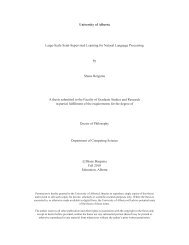The high altitude wildlife areas of western Arunachal Pradesh
The high altitude wildlife areas of western Arunachal Pradesh
The high altitude wildlife areas of western Arunachal Pradesh
Create successful ePaper yourself
Turn your PDF publications into a flip-book with our unique Google optimized e-Paper software.
Conservation status<br />
Table 4. (cont’d)<br />
SPECIES<br />
SCIENTIFIC NAME<br />
IUCN RED LIST<br />
STATUS<br />
PAKHUI<br />
NAMDAPHA<br />
PROPOSED<br />
RESERVE<br />
Red goral Nemorhaedus baileyi Vulnerable . + +<br />
Bharal Pseudois nayaur . . +<br />
Chinese goral Nemorhaedus caudatus Vulnerable . . +<br />
Himalayan goral Nemorhaedus goral . . +<br />
Himalayan marmot Marmota himalayana . . +<br />
Large eared pika Ochotona macrotis . . +<br />
Moupin's pika Ochotona thibetana . . +<br />
Musk deer Moschus chrysogaster . . +<br />
Pale weasel Mustela altaica . . +<br />
Red panda Ailurus fulgens Endangered . . +<br />
Snow leopard Uncia uncia Endangered . . +<br />
Takin Budorcas taxicolor Vulnerable . . +<br />
Tawang macaque Macaca sp. . . +<br />
Total species 33 37 27<br />
Species <strong>of</strong> global importance 10 14 10<br />
Significant resources and manpower need to be made available to the forest<br />
department with a clear mandate <strong>of</strong> <strong>wildlife</strong> conservation and implementation <strong>of</strong><br />
<strong>wildlife</strong> laws. Presently, in our survey sites, the forest department has a very small<br />
presence, with <strong>wildlife</strong> conservation issues taking a back-seat. <strong>The</strong> forest department<br />
also needs to devise means <strong>of</strong> regulating timber felling, medicinal plant collection, and<br />
the continued cutting and burning <strong>of</strong> forests.<br />
Proposed <strong>wildlife</strong> reserve<br />
<strong>The</strong> contiguous <strong>areas</strong> <strong>of</strong> the Mago Chu Valley and the <strong>high</strong> <strong>altitude</strong>s <strong>of</strong> West Kameng<br />
District together harbour the richest mammalian assemblage among our survey sites,<br />
and the most extensive <strong>high</strong> <strong>altitude</strong> <strong>wildlife</strong> habitat (Tables 2, 3). Species richness in<br />
this area is only marginally lower when compared with the two important <strong>wildlife</strong><br />
reserves <strong>of</strong> <strong>Arunachal</strong>; the low elevation Pakke Tiger Reserve, and the low to mid<br />
elevation Namdapha Tiger Reserve (Table 4). In terms <strong>of</strong> mammalian species <strong>of</strong> global<br />
conservation importance, the region is as rich as Pakke. Establishment <strong>of</strong> a <strong>wildlife</strong><br />
reserve in the Mago Chu Valley and adjoining <strong>high</strong> <strong>altitude</strong> <strong>areas</strong> <strong>of</strong> West Kameng<br />
will afford protection to the entire <strong>high</strong> <strong>altitude</strong> mammalian fauna <strong>of</strong> <strong>western</strong><br />
<strong>Arunachal</strong>, including 10 species <strong>of</strong> global conservation importance. This would also<br />
make the area the only existing <strong>wildlife</strong> reserve in the world to harbour all three<br />
species <strong>of</strong> goral, and the only <strong>wildlife</strong> reserve in <strong>Arunachal</strong> affording protection to<br />
<strong>high</strong> <strong>altitude</strong> species such as the snow leopard, the Chinese goral, and the Himalayan<br />
marmot.<br />
17

















